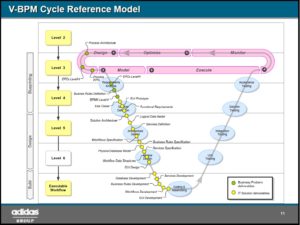Tom Bellinson of IT Methods looked at some of the reasons why BPM in small business (under 500 people) is different from that in larger businesses, based on some of the fundamental differences in how small and large businesses work, and therefore how they deal with process improvement. There are some advantages to looking at process improvement in large companies – more human and financial resources, and a longer time frame – but small businesses have the advantage that usually their processes can be understood and tackled end to end rather than piecemeal.
Because of less available resources, a big bang approach sometimes doesn’t work for small companies: the big bang is good for just getting it does all at once, but causes a great deal more stress and requires more concentrated effort. Bellinson proposes using a big bang approach for the analysis and planning phases, then implementing using a more incremental approach. This can still cause significant stress, particularly during the analysis phase when you may be challenging the company owner’s personality directly as it manifests in company culture and processes. Although process analysis always challenges management in some way in any sized company, when the owner personally created specific processes, and those processes are now being called out as broken, that can be uncomfortable all around.
To do a big bang approach to process mapping in a small business, it needs to be made a #1 priority in the company so that it doesn’t get pushed aside when the inevitable emergencies occur; you’ll also need to hire an external consultant to guide this process and gather the information, since the odds of those skills being inside your company and readily available is near zero. This is really a 2-4 week effort, not the months that it might take in a larger company, so although it will be a bit stressful and disruptive during that time, you need to bite the bullet and just get it done. The analysis itself isn’t unique to small businesses – map as-is processes, find and eliminate the non-value added activities, determine ROI – but sometimes the roles are a bit different, with the process consultant actually doing the process improvement exercise and presenting it to the company, rather than internal participants being involved in the reengineering efforts.
I’ve been approached by a few smaller businesses lately who were interested in BPM, and I think that the tools are finally at a price point that SMBs can consider implementing BPM inside their organizations. I agree with Bellinson that many of the techniques are just different for smaller businesses; having started and run two small businesses up to 40-50 people in size, I can certainly understand how the owner’s personality can have a big influence on the corporate culture and therefore the way that business processes improvement has to happen. However, there are still a lot of standard BPM principles and methodologies that can be applied, just on a smaller scale.

